The founder of the Cornell Lab of Ornithology, Arthur Allen, made the first-ever recording of bird songs in 1929. Since then, the Cornell Lab has been recording and analyzing animal sounds, including those of birds, frogs, fish, insects, and mammals like whales and elephants.
Increasingly, sound is being used as a tool for conservation—both to document the distribution and behavior of species and to track disturbances in their environments (from climate change or invasive species, for example).
Technological advances have allowed researchers (including thousands of citizen scientists around the globe) to capture animal sounds at an ever-growing scale. Machine learning software is helping researchers to analyze and visualize these sound recordings: a process which is yielding surprising new insights.
As we listen in to the sounds of other species, we are learning that they have much to tell us about the environments we co-inhabit.
The field of bioacoustics was literally founded at Cornell
And the university remains at the forefront of this field. The K. Lisa Yang Center for Conservation Bioacoustics was established in 2021, through a transformational gift from longtime supporter K. Lisa Yang ’74.
“I can’t save the world alone… This gift is about technology as a means to conserve biodiversity and to invest in and empower people living in areas of immense biodiversity, essentially the lungs of the earth.” —K. Lisa Yang ’74
From whale songs to bat whistles
Here, we share some highlights—including video and audio recordings—from the Cornell Conservation Bioacoustics Field Course on Hawaiʻi Island in January 2024. The students you see were enrolled in NTRES 3150 Introduction to Conservation Bioacoustics in fall 2023, and this winter break trip was the culmination of their classroom learning.

Students in this course received highly specialized training and experience in how to use bioacoustics technologies in real-world settings. The field course links theory to practice, so students see how bioacoustics can be applied for conservation.
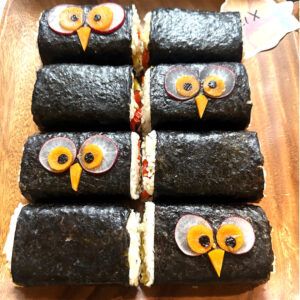
Three Cornell faculty accompanied the students: Ben Gottesman, a member of the Yang Center team who studies sound-based indicators of ecological disturbance; Aaron Rice, a bioacoustician who specializes in the sound of fishes and whales; and Alexandra Moore, a geologist and educator with deep ties to Hawaiʻi Island’s cultural and scientific communities. Alex connected the group to local expertise, facilitated opportunities for the students to connect with Indigenous ecological knowledge, and helped them plan and enjoy local-style meals.
Students followed their curiosity and developed their own bioacoustics projects focused on different Hawaiian fauna, including honeycreepers, shrimp, fish, bats, crickets, and whales. They ventured out into the forests, tidepools, and nearshore waters of Hawaiʻi to record the sounds of these species in situ and analyze their findings.
Imagine sitting in a shallow tidepool for hours trying to isolate the chewing sounds of tiny Native Hawaiian shrimp (ʻōpaeʻula). Or navigating through lava fields and dense primary forest to deploy recorders that capture the sounds of Native honeycreepers (ʻamakihi) flitting among the branches overhead. What these students saw and heard is not only delightful, but also incredibly valuable in the effort to understand these species and, ultimately, protect them from disease, habitat encroachment, and extinction.
Honeycreeper memes (yes, memes!)
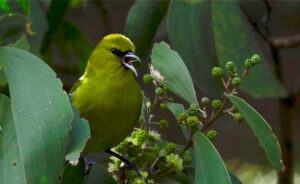
Hannah Araújo ’25 and Lucas Fink ’26 explored the variation in dialects of the Hawaiʻi ʻamakihi, one of the native Hawaiian honeycreeper species imperiled by avian malaria. (Mortality among ʻamakihi exposed to a single infective mosquito bite is 65 percent.)
The students recorded the birds in neighboring kīpuka, or forest fragments of different ages surrounded by lava. What the pair discovered is that the birds in different kīpuka had different dialects.
“Remarkably, they found that the same species sang different songs (memes) in forest fragments just a few hundred meters apart,” notes Ben Gottesman.
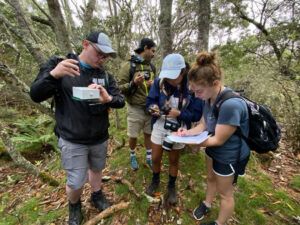
One hypothesis is that when individual birds travel between kīpuka, they change their songs to match the meme in that kīpuka. The differences between the memes are not obvious just by listening, but when the students slowed down the recordings, the differences between them were quite distinct.
“Bioacoustics analysis lets us visualize the memes, so you can clearly see the differences,” Lucas explains.
Local partner Dr. Patrick Hart, who leads the LOHE Lab at the University of Hawaiʻi at Hilo, has been studying communication of these honeycreepers for years and advised the students on their project. The students hope to continue their work to understand why the birds in different kīpuka have different memes, and they want to record and preserve as many of the memes of these endangered birds as possible for future analysis.
Shrimp chewing
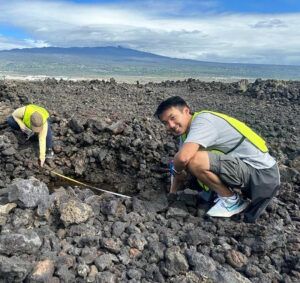
ʻŌpaeʻula are tiny shrimp which are endemic to Hawaiʻi. They have a variety of colors—red, pink, white, yellow, and clear—but they are all one species. The shrimp have been subject to overcollection for aquariums, and their habitat is threatened by overconsumption of groundwater, pollution, rising sea levels, and land use change.
These shrimp live in anchialine pools, brackish water-filled depressions in the lava located close to the ocean. Hawaiʻi Island is one of the top locations worldwide to find such pools. The pools are connected to the ocean through underground crevices, and the shrimp (and other species) move between the pools through these passages.
Cornell grad student Karianne Kapfer wondered if these tiny shrimp produce sound. The answer is yes! She recorded a variety of subtle chewing sounds in ponds where only shrimp were observed. Further recordings will be necessary to document and analyze these sounds, and to determine how we can use acoustic monitoring to better understand this species.
“There are many species and environments that have never been recorded,” Ben observes, “especially in aquatic environments. For this reason, it is an exciting time to be a bioacoustician!”
Eel gulping
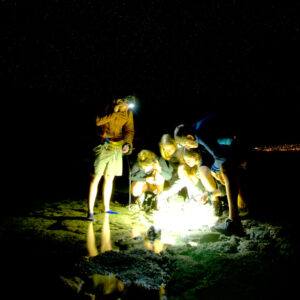
Justin and Karianne also tried to characterize the sounds of fish, some of which have never been recorded before. They discovered pretty quickly that it’s difficult to distinguish fish sounds from the background noise, including underwater plants, winds, water movement, and other aquatic species.
On a moonless night, several students went out to explore the tidepools of Puako, a seaside community with a nearshore reef. Tidepools are ideal for collecting recordings of fish and other invertebrates, and for matching sounds to species—something which can be very difficult to do in open-water aquatic environments.
The students recorded a variety of low-frequency sounds they attribute to fish—including fish pulses, fish rumbles, and fish gulps. The highlight of their tidepool sleuthing was this Hawaiian conger eel. In its mouth is a manini (convict tang).
“The eel thrashed and twisted, and tried several times to chomp down on this fish, but it proved too big for her. The eel stayed with us for several minutes, during which we got a recording of it chewing underwater,” Karianne says.
Bat calling
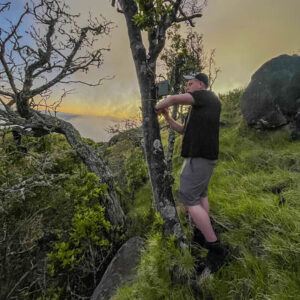
The ʻōpeʻapeʻa, or Hawaiian hoary bat, is the only terrestrial mammal endemic to Hawaiʻi. This species arrived on the island about 10,000 years ago and is currently endangered.
Kris recorded bats in two locations, Hakalau Forest National Wildlife Refuge in the northeast of the island, and Kohala Restoration Corridor in the northwest. Not much is known about the range, population density, and behavior of bats in these two areas, where they previously have not been studied.
Kris collected more than 100 recordings of bat calls at several locations. He grouped the calls into a few distinct categories: echolocation calls to navigate and find prey, social calls to find one another, and “feeding buzz” as the bats were homing in on insects.
He notes that, like the ʻamakihi, the bats seemed to have different dialects depending on where they live. As the bats hunt, they can traverse many miles, even flying between islands seeking food. He learned from local expert Corrina Pinzari that ʻōpeʻapeʻa also produce unusual whistles, potentially to communicate across larger distances—and he was able to capture this rarely documented sound.
Cricket chirping
Lucas Fink ’26 spent two days searching for a UFO (unidentified falsetto orthopteran) amidst the tree ferns and giant ‘ōhi‘a lehua trees of Hakalau Forest National Wildlife Refuge. He and a few other students used shotgun microphones to home in on this cricket.
They were finally able to find and collect some specimens, and they’re now investigating if this is a new species back at Cornell. Enjoy this cricket’s soft song, which it makes sporadically throughout the day.
Whale singing

Fortunately for the ‘whale team’—Kathryn Fligstein ’24, Gianna Haro ’24, and Samantha Juber (visiting scholar)—the humpback whales made their annual winter migration to Hawaiʻi early this year. The ocean surrounding the island was filled with whale song.
The students worked with researchers at the Hawaiʻi Marine Mammal Consortium (HMMC), led by former Cornell Lab postdoc, Adam Frankel. The HMMC has been tracking humpback whales in their Hawaiian breeding grounds for more than 20 years.
According to HMMC experts, male humpback whale song is one of the most complex vocalizations in the animal kingdom. They are still testing their hypothesis that, “one way that females choose a mate is by evaluating male singers based on the acoustic qualities of their song.”
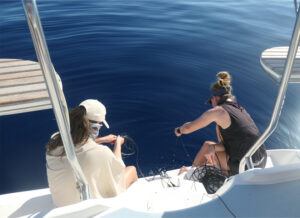
The whale team sought to record various individuals in order to characterize this year’s song. While in a particular breeding area, humpback males repeat phrases of the same song over and over—sometimes singing alone and sometimes together in ‘choruses.’
The students also compared their recordings to those of previous years to assess differences in response to stressors, such as warming ocean temperatures. The whale team noted that marine heat waves have been accelerating, bringing disruptions to the marine food web that whales rely upon. Team members hypothesized that these stressors may contribute to a more fragmented whale song (in which whales do not complete a full song), but further bioacoustic research is needed to confirm this prediction.
Hidden wisdom of songs

Now back in Ithaca, the students continue to analyze their acoustic datasets—applying modern recording techniques to better understand ecosystems in flux. Course faculty are looking ahead to next year.
“Learning through listening has long been a practiced value in Hawaiʻi,” Ben observes.
He describes how on the first day of the 2023 field course, local partner Lisa Mason taught the group an ‘oli, or traditional Hawaiian chant, called E Hō Mai. Translated, it means:
Grant us wisdom from above
That which is embedded into the lyrics of songs
Endow us
Enrich us
Enlighten us
“The songs of other species have much to teach us, and we are learning so much from listening in,” Ben says.


